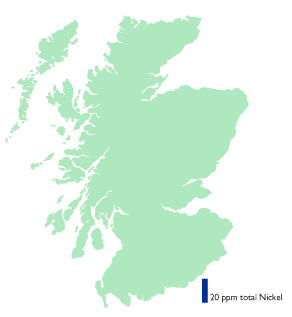Nickel
 The average concentration of nickel in the Earth's crust is around 90mg/kg but, in soils, there can be considerable variation in the natural levels depending on the nature of the parent rocks. Soils developed on basic and ultrabasic parent materials can have extremely high Ni contents that can approach toxic levels. Ni is a siderophilic element and tends to associate with sulphidic phases. In sedimentary rocks it is frequently associated with organic-rich deposits. Ni is now known to be an essential element for some organisms. Although its exact physiological role is not known the levels of Ni required by both plants and animals are very low and it is unlikely that deficiency will be encountered. At higher concentrations, Ni is known to be toxic to both plants and animals, whereas at very high levels of exposure, Ni salts are known to be carcinogenic. For the samples in this study the Ni contents vary by an order of magnitude from 3 to 30mg/kg. Both transects 1 and 2 show very low Ni contents whereas in transect 3 the levels are much higher with a transect mean of 22 mg/kg but with considerable variability. For transect 4 the overall mean drops to lower values but not as low as those obtained for transects 1 and 2. As with the other metals the values for soils receiving sewage sludge tend to have been adopted as environmental standards for soils but the values recorded here, with one exception, are below both the recommended (30mg/kg) and the maximum (75mg/kg) permissable values.
The average concentration of nickel in the Earth's crust is around 90mg/kg but, in soils, there can be considerable variation in the natural levels depending on the nature of the parent rocks. Soils developed on basic and ultrabasic parent materials can have extremely high Ni contents that can approach toxic levels. Ni is a siderophilic element and tends to associate with sulphidic phases. In sedimentary rocks it is frequently associated with organic-rich deposits. Ni is now known to be an essential element for some organisms. Although its exact physiological role is not known the levels of Ni required by both plants and animals are very low and it is unlikely that deficiency will be encountered. At higher concentrations, Ni is known to be toxic to both plants and animals, whereas at very high levels of exposure, Ni salts are known to be carcinogenic. For the samples in this study the Ni contents vary by an order of magnitude from 3 to 30mg/kg. Both transects 1 and 2 show very low Ni contents whereas in transect 3 the levels are much higher with a transect mean of 22 mg/kg but with considerable variability. For transect 4 the overall mean drops to lower values but not as low as those obtained for transects 1 and 2. As with the other metals the values for soils receiving sewage sludge tend to have been adopted as environmental standards for soils but the values recorded here, with one exception, are below both the recommended (30mg/kg) and the maximum (75mg/kg) permissable values.

